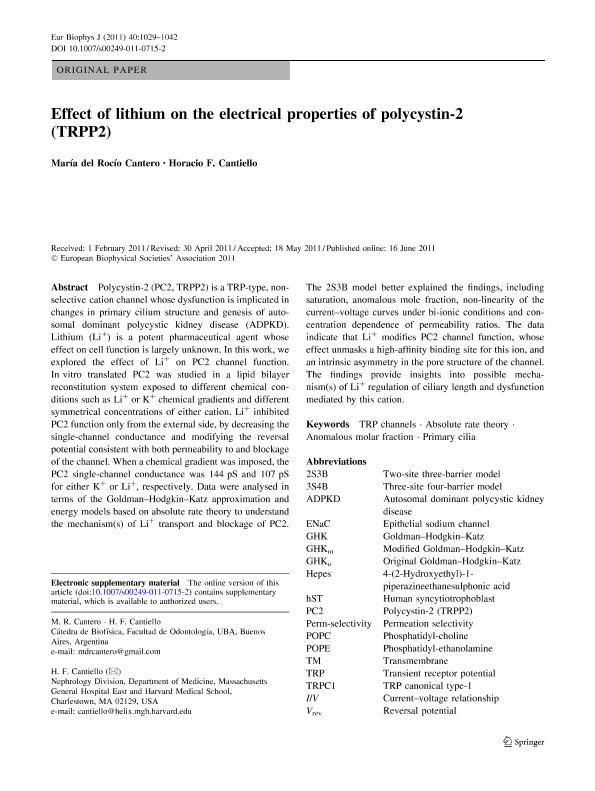Mostrar el registro sencillo del ítem
dc.contributor.author
Cantero, Maria del Rocio

dc.contributor.author
Cantiello, Horacio Fabio

dc.date.available
2017-02-22T19:57:26Z
dc.date.issued
2011-06
dc.identifier.citation
Cantero, Maria del Rocio; Cantiello, Horacio Fabio; Effect of lithium on the electrical properties of polycystin-2 (TRPP2); Springer; European Biophysics Journal With Biophysics Letters; 40; 9; 6-2011; 1029-1042
dc.identifier.issn
0175-7571
dc.identifier.uri
http://hdl.handle.net/11336/13327
dc.description.abstract
Polycystin-2 (PC2, TRPP2) is a TRP-type, non-selective cation channel whose dysfunction is implicated in changes in primary cilium structure and genesis of autosomal dominant polycystic kidney disease (ADPKD). Lithium (Li+) is a potent pharmaceutical agent whose effect on cell function is largely unknown. In this work, we explored the effect of Li+ on PC2 channel function. In vitro translated PC2 was studied in a lipid bilayer reconstitution system exposed to different chemical conditions such as Li+ or K+ chemical gradients and different symmetrical concentrations of either cation. Li+ inhibited PC2 function only from the external side, by decreasing the single-channel conductance and modifying the reversal potential consistent with both permeability to and blockage of the channel. When a chemical gradient was imposed, the PC2 single-channel conductance was 144 pS and 107 pS for either K+ or Li+, respectively. Data were analysed in terms of the Goldman–Hodgkin–Katz approximation and energy models based on absolute rate theory to understand the mechanism(s) of Li+ transport and blockage of PC2. The 2S3B model better explained the findings, including saturation, anomalous mole fraction, non-linearity of the current–voltage curves under bi-ionic conditions and concentration dependence of permeability ratios. The data indicate that Li+ modifies PC2 channel function, whose effect unmasks a high-affinity binding site for this ion, and an intrinsic asymmetry in the pore structure of the channel. The findings provide insights into possible mechanism(s) of Li+ regulation of ciliary length and dysfunction mediated by this cation.
dc.format
application/pdf
dc.language.iso
eng
dc.publisher
Springer

dc.rights
info:eu-repo/semantics/openAccess
dc.rights.uri
https://creativecommons.org/licenses/by-nc-sa/2.5/ar/
dc.subject
Lithium
dc.subject
Pc2
dc.subject
Primary Cilia
dc.subject.classification
Otras Ciencias de la Salud

dc.subject.classification
Ciencias de la Salud

dc.subject.classification
CIENCIAS MÉDICAS Y DE LA SALUD

dc.title
Effect of lithium on the electrical properties of polycystin-2 (TRPP2)
dc.type
info:eu-repo/semantics/article
dc.type
info:ar-repo/semantics/artículo
dc.type
info:eu-repo/semantics/publishedVersion
dc.date.updated
2017-02-15T14:09:49Z
dc.journal.volume
40
dc.journal.number
9
dc.journal.pagination
1029-1042
dc.journal.pais
Alemania

dc.journal.ciudad
Berlín
dc.description.fil
Fil: Cantero, Maria del Rocio. Universidad de Buenos Aires. Facultad de Odontología; Argentina
dc.description.fil
Fil: Cantiello, Horacio Fabio. Harvard University; Estados Unidos. Massachusetts General Hospital East; Estados Unidos. Consejo Nacional de Investigaciones Científicas y Técnicas; Argentina
dc.journal.title
European Biophysics Journal With Biophysics Letters

dc.relation.alternativeid
info:eu-repo/semantics/altIdentifier/url/http://link.springer.com/article/10.1007/s00249-011-0715-2
dc.relation.alternativeid
info:eu-repo/semantics/altIdentifier/doi/http://dx.doi.org/10.1007/s00249-011-0715-2
Archivos asociados
